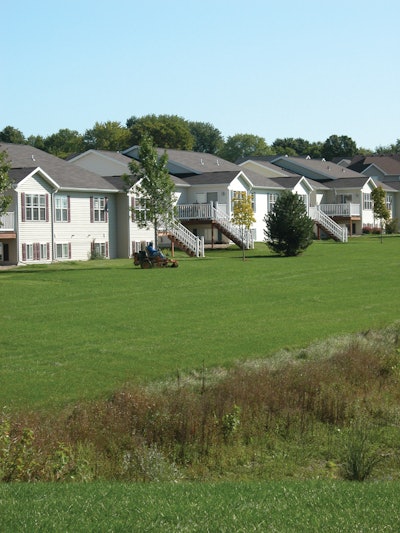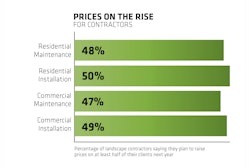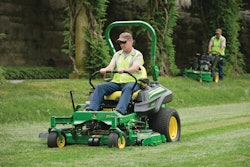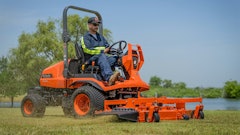
Production of apartment buildings and condominiums has been on fire for the past few years. In fact, according to the National Association of Home Builders (NAHB), builders and developers have been more jazzed about multi-family market conditions than any other time over the past decade.
The NAHB expects this positive trend to continue this year, although the pace of growth is expected to cool down and eventually begin leveling off later this year and into 2016. Nonetheless, David Crowe, NAHB chief economist, said the following in late-January at the NAHB International Builders’ Show (IBS) in Las Vegas: "We are forecasting that 358,000 units will be developed in 2015 and 361,000 units in 2016. One of the indicators for our forecast is NAHB’s Multi-family Production Index, which is a survey of our members’ attitudes toward the market. They have been telling us that the market is very strong and is expected to stay that way for the foreseeable future.”
One of the markets in particular that has strong demand is affordable rental housing. “There are many families in America that have a great need for affordable housing,” said Mike Costa, president and CEO of Highridge Costa Housing Partners LLC in Gardena, CA. “We have a long waiting list for our apartments at all of our communities. There is a need for us to be building more.”
Panelists at the IBS Show press conference also discussed the current design and amenity trends they are seeing in the overall multi-family industry. “Green and energy-efficient features and building practices continue to be popular, including high-efficiency appliances and mechanical systems, green roofs, locally sourced building materials and the recycling of construction waste,” said Sanford Steinberg, AIA, CGP, principal of Steinberg Design Collaborative LLP in Houston.
The continued strength of the multi-family housing market continues to create opportunity for landscape maintenance contractors. But many contractors often perceive apartment and condominium complexes to be very demanding, time-consuming properties. While there may be some truth to that, these clients can be a great source of revenue. Contractors just need to understand how to work with them.
If you decide that you want to maintain apartment and condominium complexes, you likely need to modify your sales, estimating and operations processes to accommodate this market segment. You are not dealing with your typical commercial client where a few weeds behind the dumpster may be overlooked. You are dealing with people’s homes—and they expect a higher level of service.
1. Get Your Head Right
Not all landscape contractors have the physical nor mental makeup to put up with the expectations and demands of the multi-family market segment. Even if your DNA is programmed to accept the challenge, you need to take into account the PITA Factor (Pain In The ***) which can lead to CAD (Condominium/Apartment Anxiety Disorder).
You and your staff have to be able to tolerate this type of client or you will find yourselves burnt out in a short period of time. Thus, when pricing this type of work, you need to assess an additional fee based on the amount of PITA and CAD associated with a job. If you don't, you will likely end up resenting the client and his or her demands. That often leads to reduced quality, which is never good for your reputation.
Before submitting a proposal, you should attend a board meeting, a meeting with the landscape committee, and a meeting with the property management company. This will help you size up the degree of work, along with the PITA and CAD you will be dealing with. The reality is that you are dealing with homeowners on a very large scale, and your price needs to reflect the extra work required.
2. Get Your DMU Right
When selling to these clients, you will find that you are dealing with two market segments: condominiums and apartments, and upscale and affordable. No matter which one you choose to work with, you will see that they both require a level of service that is much different than the commercial and industrial market.
You also need to understand whom you should be talking with and selling to. Rock-star sales pros often refer to something called the "decision-making unit", or DMU, which comprises those key individuals who will ultimately influence a purchase.
At an apartment complex, your point of contact will often be the operations manager. You need to develop a rapport and trust with this individual. This person is your direct link to the on-site manager and regional staff.
When it comes to a condominium complex, you are going to be dealing with the property manager and in many cases a member of the board of directors. This is where it gets tricky. Many board members take a very active role when it comes to the landscape of their property. You need to develop a strong relationship with both the board and the management company. Property management companies come and go, which is why you need to gain the trust of several of the board members.
Eric Storck is the president of Blade Runners in Fairfax, VA. Blade Runners specializes in condos and HOAs, along with some apartment buildings. Storck says it is indeed all about relationships in the multi-family maintenance business.
"Apartments can be tough," Storck relates. "Many of the management companies are so huge that it's hard to get to the top people. Many times when we do get a call, it's just an administrative person gathering information. I've joined apartment manager associations, which has helped a little. Relationships are also multi-tiered; owner to owner, account manager to account manager, and crew leader to complex manager. It has to happen at every level."
3. Get Your Price Right
The surge in renting has created a great deal of competition in the multi-family market. Property owners and managers are always looking for a niche. Beautiful landscaping that attracts renters/owners, while also helping to maintain real estate value, is a nice niche. With a solid sales approach that emphasizes quality, service, responsiveness and value, you can turn your potential client's focus away from price.
But that does not mean you have the green light to charge whatever you feel. This is merely an opportunity to show that your company understands the client's needs and is still competitive in the marketplace.
Storck says the pricing pressure from both national landscaping companies and large regional companies has been persistent.
On the condo side, though, it has been a bit easier. "These clients are typically more receptive to 'value' in general," Storck says. "Back in 2005 you could almost write your own ticket. Then in 2008 it was all about price. Now many of our condo customers are looking at multiple services again." Blade Runners offers several in-house services from mowing and parking lot sweeping to lawn and tree care.
There are always going to be portions of this market segment that are price-driven. That is why you must have a full understanding of the scope of work. Clients may say that they are not looking for attention to detail. However, the reality is that they are—even if they try to use a vague set of specifications.
4. Get Your Promises Right
If you obtain some work in this market segment, you need to start focusing on a process to effectively manage the client and property. It is a fallacy that these types of clients like to change contractors on an annual basis. The reality is that they are very picky and want things done to their liking. When the contractor fails to live up to their expectations, however, the client will re-bid the work. Therefore, it's really in your court.
Before the first crew is sent to the property, the contractor needs to look in the mirror and ask: Do I have a plan in place to run this job as I promised during contract negotiations? Have I assembled the type of crew needed to perform per the contract? What type of checks and balances are in place to deal with the unforeseen?
To be successful in this market segment, you need to take a proactive approach to managing the site. Here are a few key items that need to be part of a successful plan:
- Put together an organizational chart for the property so that the client understands the chain of command for all aspects of the project including weekly operations, billing and administrative issues. Include names, titles, responsibilities and contact information.
- Set up an initial meeting with the client to introduce the key players on the crew.
- Reaffirm with the crew and the client's representative all items that were discussed during contract negotiations. This could include where breaks are allowed, where you mobilize on a weekly basis, where you start and finish, noise concerns, and the check-in process.
- Provide all parties with a site map that highlights many of the key issues listed above.
- Schedule monthly site reviews. This should be a written report signed by both parties. This eliminates the “he said she said” when a situation arises.
- Schedule an internal site review prior to the crew leaving the property. This will help identify something that may have been missed or an issue that needs to be brought to the client's attention.
- All parties involved with the property should be communicating with the client on a regular basis. Once a month is not enough. Your visibility on the site shows the client that you are truly interested in their property.
- Take the time to speak with the property or site manager as well as their operations staff.
- Make suggestions to improve the property. You do not want to come across as a high-pressure salesperson. What you want to do is show that you are concerned about the property. Always give the client options.
- Attend monthly board or landscape committee meetings to build rapport.
5. Get Your Scheduling Right
Determine the day of week the client wants to be maintained. Most residential-type clients prefer Thursday or Friday. Hopefully you can accommodate them. At the same time, most properties will not allow you to work on the weekend. Plus, you need to leave room in your schedule for bad weather. How do you work around this dilemma?
You might be able to move some clients to a Tuesday or Wednesday just by offering an incentive, which doesn't necessarily have to be a price reduction. You may offer some additional weeding or a few extra annuals. In many cases the benefits outweigh the costs. Plus, you may have a maintenance crew looking for work on a Tuesday or Wednesday anyway.
Once you have established your work schedule and communicated it to your client, you need to be sure that you perform as promised. This business is as much about trust as it is about doing the actual work.
Your start time may be later than your typical commercial property. That doesn’t mean you can't be on site doing some weeding or other projects that do not require loud equipment. This is simply something that needs to be communicated to the crews so that all parties are on the same page.
It's pretty simple: Communication will lead to a minimal amount of aggravation. This is especially true when it comes to lawn chemical treatments on residential properties. You need to give all properties ample time to notify residents.
6. Get Your Crews Right
Having a solid crew that understands the chain of command, is cultured in the fine art of attention to detail, and has strong communication skills is a formula for success. A strong handbook of policies and procedures is the key.
Your crews then need to know everything about the property, such as start time, where to start working, where to park the equipment, where to take breaks, and who their on-site contact is.
Your crews should be properly uniformed in a manner that distinguishes a laborer from a foreman, and a foreman from a manager. Your clients need to understand this as well.
Your crews need to understand “Condominium Communication Correctness 101” which states that no matter how many times you are approached by a unit owner, resident or staff member, you need to refer them to the appropriate individual on your crew or within your company that has been granted permission to talk.
7. Get Your Production Right
In most cases, you will not have to retool to take on condominium and apartment complexes. But you may have to educate your estimators and crews on the art of perception.
For instance, even though a certain riding mower may be able to cut at a moderate rate of speed and provide a quality job, this may not fly with this market segment. Remember, you are dealing with multiple homeowners on every site. They want you to take the time to do a good job. They do not care that your zero-turn can cut at full throttle. They perceive speed with poor quality. You need to make sure that both your estimators and crews understand this.
Additionally, clean, well-maintained equipment says a lot about your company. Your clients do look, and they do care.
In fact, when it comes to multi-family clientele such as apartment and condominium complexes, they care an awful lot—about their landscaping, that is. Pay attention to the seven areas discussed in this article so you can reap some of the benefits of a strong multi-family residential construction market.




















